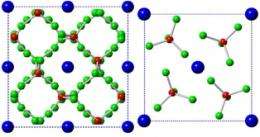Theoretical research reveals that experimental crystal structure of an important energy material is impossible

(Phys.org)—An international team led by Xiang-Feng Zhou and Artem R. Oganov, PhD, theoretical crystallographers in the Department of Geosciences and Department of Physics and Astronomy at Stony Brook University, have established the structure of one of the most important high-energy-density materials, magnesium borohydride or Mg(BH4)2. Their findings, "First-Principles Determination of the Structure of Magnesium Borohydride," have been published in the December 13 edition of Physical Review Letters.
"Experimental crystal structure determination is often viewed as a routine task with a guaranteed correct result, but we successfully challenged the 'experimental' structure of δ-Mg(BH4)2 ," said Zhou. "This material contains nearly 15 wt. % hydrogen, which makes this an important energy material," added Oganov.
Structures of several modifications of Mg(BH4)2 were known from high-quality powder diffraction data, a rather standard method for determining crystal structures of materials. Researchers used Prof. Oganov's breakthrough evolutionary method for crystal structure prediction, aiming to find the most stable structures of Mg(BH4)2 at different conditions.
To Zhou's surprise, among the theoretically predicted structures he did not find the structure earlier proposed by experimentalists for the δ-phase. He then investigated the experimental structural model and found it to be very unfavorable compared to the theoretically predicted models. Even worse, the "experimental" structure was found to be unable to sustain its own lattice vibrations - predicted to fall apart as a result of atomic thermal motion. This indicates that the "experimental" structure is absolutely impossible – even as a metastable state.
Comparing the diffraction patterns of the theoretically predicted structure with experiments, Zhou realized that there is a perfect match. Subsequently, he found yet another structure that matches experimental data. Thus, there are at least three completely different crystal structures that match experimental diffraction data, but one of them – the one claimed by experimentalists – has been ruled out. The other two structures were shown to explain another mystery - the existence of two almost indistinguishable phases called δ and δ' (previous experiments were unable to propose any solution for the latter). Zhou and colleagues determined the structures of these phases to have symmetries I41/acd and P-4.
"It is indeed surprising that experimental work, based on high quality data, failed to correctly solve these simple and highly symmetric crystal structures, containing only six non-hydrogen atoms," said Zhou. "We were also surprised to see completely different structures having identical diffraction patterns. In such situations, which may be more common than we expect, theoretical structure searching will play a major role."
"Crystal structure is the basis for understanding the behavior of materials," said Oganov. "The possibility to predict crystal structures is a major breakthrough of our time and will prove crucial for the future discovery of new materials."
More information: prl.aps.org/abstract/PRL/v109/i24/e245503
Journal information: Physical Review Letters
Provided by Stony Brook University



















